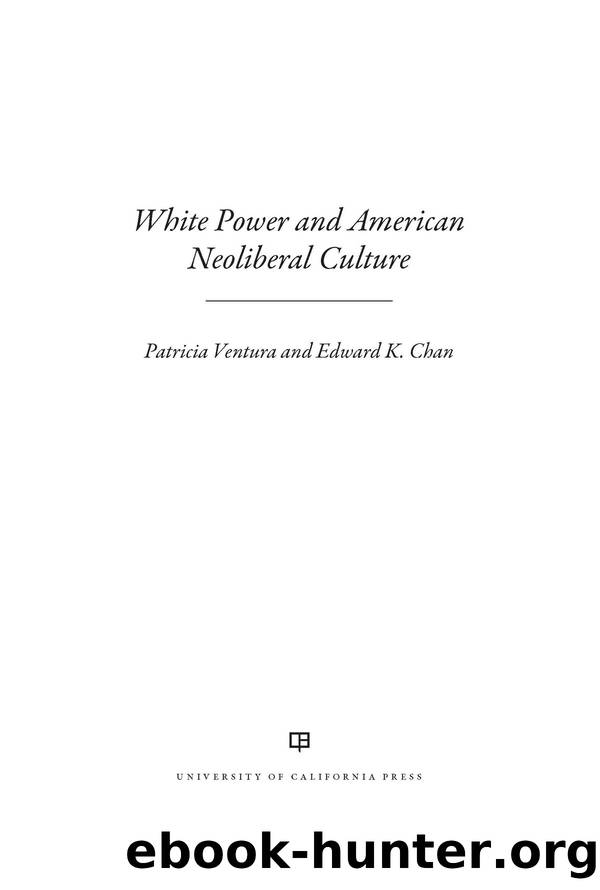White Power and American Neoliberal Culture by Ventura Patricia;Chan Edward K.;

Author:Ventura, Patricia;Chan, Edward K.;
Language: eng
Format: epub
Publisher: University of California Press
During my high school days, I became racially aware as I noticed the vast differences between Whites and [n-----s]. I realized that I preferred my own Race while abhorring the obnoxious behavior and stupidity of the inferior blacks. My high school was mostly White but there was a large population of blacks so that I could see first hand that the notion of equality was simply a fairy tale. Being in honor and AP classes, I saw first hand the superiority of the White Race as my classes were overwhelmingly White.28
Although this anecdotal passage disregards the structural and institutional racism that affects educational demographics, the sentiment can easily be reified in the experience of other, and even less extreme, white people. Molyneaux goes on to describe his embrace of neo-Nazism along with acceptance of the belief in a Jewish conspiracy and his indoctrination into the WCOTC.
In his history of the WCOTC, political scientist George Michael explains that Klassen led far-right and white racist organizations away from Christianity toward a self-described âtheologyâ according to which the white race is destined to take over the entire world and eliminate all Jewish people and âmud peopleâ (i.e., nonwhites).29 In The White Manâs Bible, originally published in 1981, Ben Klassen lays out four dimensions of Creativity in its practice of âSalubrious Livingâ encapsulated in the saying âa Sound Mind in a Sound Body in a Sound Society in a Sound Environment.â This program includes what is essentially a vegan diet, regular exercise, interaction with âour White Racial Comrades,â âhealthy expression of our sexual instincts,â rejection of medicinal drugs, and fasting.30 This salubrious lifestyle becomes a refrain in Molyneauxâs book.
For Creators, the racial identity of whiteness supersedes national identities, and the WCOTC provides the only means to unify the white race against its enemies. The groupâs âSixteen Commandmentsâ requires whites to âassure and secure for all time the existence of the White Race upon the face of this planetâ (echoing Laneâs â14 Wordsâ), âpopulate the lands of this earth with White people exclusively,â treat âthe inferior colored races [as] our deadly enemiesâ (especially Jewish people), and, central to our argument here, âhonor, protect and venerate the sanctity of the family unit.â31 Once again, hegemonic neoliberalismâs fundamental social unit, which coincides with white power advocatesâ emphasis on reproducing the white race, and tribal loyalty are key to the ideology. Klassen was no stranger to others espousing similar white power ideologies, including Pierce and Covington, both of whom he communicated with despite antagonism with each.32 Several acts of deadly violence have been attributed to terrorists (or would-be terrorists) influenced by the WCOTC, including various murder sprees and plans to assassinate high-profile Black leaders including Al Sharpton, Louis Farrakhan, and even Public Enemyâs Chuck D and N.W.A.âs Eazy-E33âall in the name of âacceleratingâ the race war, as we see with other white power ideologues and terrorists. And although the WCOTC was and remains a fairly small-scale fringe movement and is currently fragmented, âit has had a disproportionate influence on the broader racialist movement,â34 perhaps most famously with the term RaHoWa.
Download
This site does not store any files on its server. We only index and link to content provided by other sites. Please contact the content providers to delete copyright contents if any and email us, we'll remove relevant links or contents immediately.
| Anarchism | Communism & Socialism |
| Conservatism & Liberalism | Democracy |
| Fascism | Libertarianism |
| Nationalism | Radicalism |
| Utopian |
The Secret History by Donna Tartt(16606)
The Social Justice Warrior Handbook by Lisa De Pasquale(11485)
Thirteen Reasons Why by Jay Asher(7780)
This Is How You Lose Her by Junot Diaz(5753)
Weapons of Math Destruction by Cathy O'Neil(5029)
Zero to One by Peter Thiel(4816)
The Myth of the Strong Leader by Archie Brown(4785)
Promise Me, Dad by Joe Biden(4440)
Stone's Rules by Roger Stone(4412)
Beartown by Fredrik Backman(4403)
How Democracies Die by Steven Levitsky & Daniel Ziblatt(4392)
The Fire Next Time by James Baldwin(4336)
100 Deadly Skills by Clint Emerson(4070)
A Higher Loyalty: Truth, Lies, and Leadership by James Comey(4024)
Rise and Kill First by Ronen Bergman(4008)
The David Icke Guide to the Global Conspiracy (and how to end it) by David Icke(3875)
The Farm by Tom Rob Smith(3869)
Secrecy World by Jake Bernstein(3773)
The Doomsday Machine by Daniel Ellsberg(3725)
